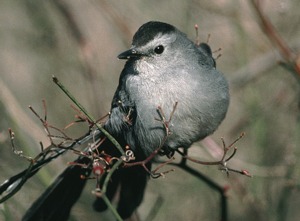
|
Breeding Season 2010
Hannah Suthers
In contrast to last summer's ample rain, this nesting season was
dryer than normal with unprecedented heat, June being the driest and
warmest on record (starting in 1895). Forbs, shrubs and saplings
were wilting in June. The heavy spring fruit sets on shrubs started
shriveling or dropping off. Stressed trees started to drop leaves by
July.
The singing male census held its own with 64 nesting species,
missing being the Willow Flycatcher, both Cuckoos, and Yellow-breasted
Chat. Neotropical migrant species on territory dropped again to 38% of
all species from the high of nearly 47% in 1985. Neotropical migrant
numbers are slowly drifting down from the peak of 57% of singing males
censused in 1995 to 40%. Effects of the rained out nesting season of
last year are showing. Our big February snow reduced Carolina Wrens,
Nuthatches. And I can't help but wonder if two weather events didn't
have something to do with this decline: a recent-year spring storm
that blew off-land at the Gulf during spring migration and resulted in
drowned songbirds washing up on the beaches; and an October tropical
storm up the Atlantic coast that blew 11 species of our migrant
songbirds, plus 2 sandpiper species, an egret and a teal to the small
island Corvo in the Azores on 17 Oct 2009. These events imply large
flocks of birds lost at sea.
Constant effort mist-netting and banding for the Monitoring Avian
Productivity and Survivorship program resulted in 186 new birds of 30
species, a 22-year low. 2008 had 341new birds of 43 species. Returns of
birds banded in previous years held up at 18%, or 40 birds of the 226
individuals captured. Of these 40, 15 birds were banded as fledglings
last year: 6 Catbirds and 9 other birds. Individual high ages were:
Catbird 9 years old, three 6 years, two 5 years; Wood Thrush after 6
years; Hybrid Chickadee 7 years, Tufted Titmouse 5 years.
The young of all species took a hit again this year. Among the
ground nesters there were only 7 Ovenbird fledglings compared to 15
in the last good nesting season of 2008, no Towhee fledgling and 1
Blue-winged Warbler fledgling. Other target fledglings banded were only
2 Wood Thrushes compared to 15 in 2008 and only 21 Catbird compared to
69 in 2008. The first Catbird fledgling appeared in the nets at the
usual time, end June, and three waves of fledglings were evident.
As cooperators with the University of California LA Center for
Tropical Research and The Conservation Genetics Resource Center, we
pulled two tail feathers from each of 121 birds. The DNA in skin cells
attached to the quill is used to determine the population origin
of an individual bird, and stable isotope analysis of a portion of
the feather is used to determine the latitude where the feather was
grown. Researchers are trying to determine migratory connectivity,
that is, the wintering grounds for specific populations of breeding
birds and vice versa. The conservation implications are tremendous.
Another researcher is looking for traces of West Nile Virus RNA that
can be extracted from the feather calamus of previously exposed birds.
For more information on these and other fascinating projects click
here.
The species list follows, the numbers being singing/displaying males
on territory throughout unless specified by dates.
| Common Name | Count & Comments |
| Great Blue Heron | frogging in pond 2x, July 11 week |
| Wild Turkey | 2 |
| Canada Goose | 2 pr, nests predated |
| Mourning Dove | 8 |
| Black Vulture | 2 flyover June 13 |
| Turkey Vulture | 3 pairs |
| Cooper's Hawk | 1, calling fledgling Aug 8, 26, 29 |
| Red-tailed Hawk | 2 pair, routinely mobbed. Calling fledgling Aug 1-3, 15 |
| Screech Owl | 3, Aug 15, 22 |
| Great-horned Owl | 1 + pair, Aug 8, 15 |
| Chimney Swift flyover | June 6, July 25, 31, Aug 7 |
| Ruby-throated Hummingbird | 1 |
| Red-bellied Woodpecker | 20 |
| Downy Woodpecker | 9 |
| Yellow-shafted Flicker | 7 |
| Pileated Woodpecker | 2 |
| Eastern Wood Pewee | 5 |
| Eastern Phoebe | 3 |
| Great-crested Flycatcher | 4 |
| Tree Swallow | pair |
| Barn Swallow | 4 pairs, 21 fledglings |
| Blue Jay | 20 |
| American Crow | 3 |
| Carolina Chickadee | 9 |
| Black-capped Chickadee | 2 |
| Hybrid Chickadee | 3 |
| Tufted Titmouse | 19 |
| White-breasted Nuthatch | 4 |
| Blue-gray Gnatcatcher | 2 |
| House Wren | 4 |
| Carolina Wren | 4 |
| House Finch | 4 |
| American Goldfinch | 4 |
| Chipping Sparrow | 5 |
| Song Sparrow | 8 |
| Field Sparrow | 2 |
| Eastern Towhee | 20 |
| Northern Cardinal | 30 |
| Rose-breasted Grosbeak | 11 |
| House Sparrow | 7 |
| Red-eyed Vireo | 13 |
| Black-and-white Warbler | 2 |
| Blue-winged Warbler | 2 |
| Yellow Warbler | 1 |
| Ovenbird | 16 |
| Common Yellowthroat | 20 |
| Brown-headed Cowbird | 6 |
| Red-winged Blackbird | 3 |
| Baltimore Oriole | 10 |
| Common Grackle | 7 |
| European Starling | 2 |
| Scarlet Tanager | 8 |
| Northern Mockingbird | 1 |
| Gray Catbird | 48 |
| Eastern Bluebird | 2, 2 broods each |
| Wood Thrush | 18 |
| Veery | 14 |
| American Robin | 47 |
Hannah Suthers and the Featherbed Lane Banding Station Crew
|

